An Anatomical Analysis of Barefoot Running
My Analyze over the ocean
My Analyze over the sea
My Analyze over the ocean
So bring back my Anatomy!
- Anon
|
Extremely simplified illustration of the biomechanics of forefoot landing (be sure to click the > button to start the (rather slow, be patient!) animation:
|
Physician Heal thy Heel
Many (but not all!) sports podiatrists seem to be adamantly opposed to the notion of running barefoot. I believe that, although their reasoning may correct, it based on the false assumption that barefoot running technique is the same technique used by most shod runners. It is NOT. My running biomechanics are VERY different from the way I used to run in shoes. Significantly, there is no heel strike. For that reason, BR is far more gentle on the knees. That said, it is possible to perform a gentle forefoot while wearing shoes, but the padding they provide allows the runner to slip back into bad habits.
In my adjacent drawing you can see why the conventional technique of heelstrike landings jars the knee and crunches the heel. No wonder running shoes have to much cushioning in the heel. Unfortunately, it serves only to dull the pain, mask the symptom and thereby allow the damage to accumulate, stride by stride.
|
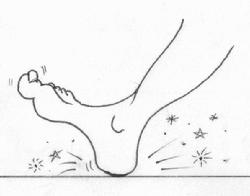 |
| Heel Strike Landing (Ow! BADDD!!) |
|
|
Here are three illustrative frames from the video that catch both my own traditional barefoot running style (forefoot landing) and a nearby jogger's conventional running style (heel-strike landing). A very fortuitous juxtaposition showing the contrasting styles!
Note that the dog, running unshod behind the jogger, also uses the traditional forefoot landing! Dogs and most quadripeds run literally on their toes; the "reversed knee" is actual the dog's heel. The knee is up near the torso. That's why they run so much faster than even an Olympic track star -- the long "foot" offers a terrific lever arm! Our own foot anatomy, optimized for upright walking, offers bupkiss in terms of running speed!
|
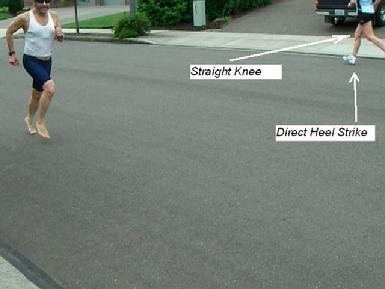 |
| Conventional heel strike landing |
|
|
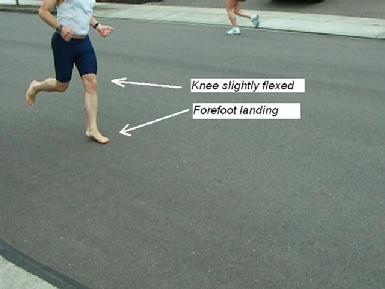 |
| Forefoot landing |
|
|
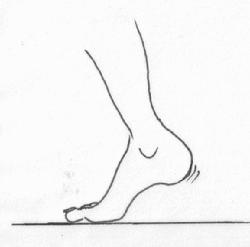 |
| Forefoot Landing (Ahhh ... GOOD!!) |
|
|
It's interesting that quadrupeds and virtually all other bipeds (kangaroos, etc.) use the forefoot landing technique. We say they "walk on their toes". Take a look at the dog in the picture. Its "foot" is so long it looks like part of its leg. It is not. The true leg -- the upper (femur), middle (knee) and lower (tibia / fibula) -- are tucked up near the body. Compared to our stubby foot, the dog's foot is a long lever arm that preloads and launches powerfully forward. No wonder even small animals can outrun an Olympic track star. We think we're such hot stuff, we homo sapiens, but we'd do pitifully in an all-species athletic competition!
Finally, and I need to expand on this, the spreading of the toes during the forefoot landing is a tremendous stabilizer against pronation and/or supination. At the risk of sounding like a cheesy late-night testimonial, I stopped needing my orthotics since I started running barefoot. The trick is to keep doing the spread-toe forefoot landing even when wearing shoes or sandals.
Disclaimer: I am not saying you could or should throw away your orthotics if you use barefoot running technique. I'm just saying that in my case, I found that strong, actively engaged feet obviated my need for orthotics. Yes, it's anecdotal evidence based on a sample size of 1, but it's an interesting piece of data that merits further investigation -- in my humble opinion!
|
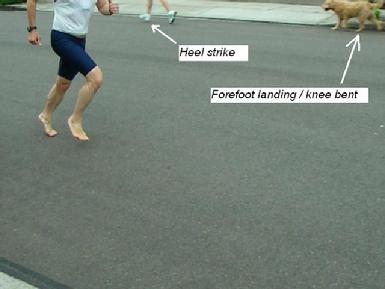 |
| Heel strike versus forefoot |
|
|
|